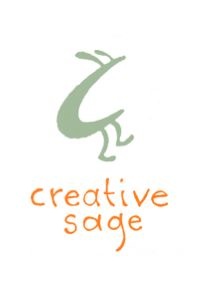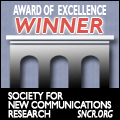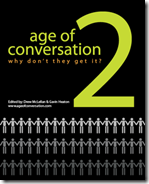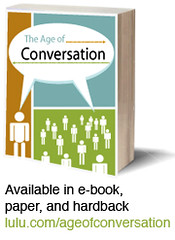How do we resonate with, and gain the trust of employees, customers, and constituents in the Collaborative Economy? How do we support each other in doing our best possible work, in each person’s optimum work situation? If you have not watched the animated video above, courtesy of RSA Animate, I strongly recommend you watch it now. It’s fun, delightful, and truthful, full of vital points about creating a modern work culture that works for customers, as well as employees, contractors, and other constituents. The ultimate message is that we need to create a culture of openness and trust, in this era of social business, collaboration, and rapid innovation.
As I mentioned in my post, “Shoot Out at the Social Corral — Riding to a New Range Under the Open Sky” in late 2012, I had come to realize that, although my company was still strategizing, managing, and producing important integrated marketing, public relations and social media outreach campaigns — and sometimes, social advocacy, fundraising and donor relations campaigns — we were seeing several important shifts in the Social Business landscape. These shifts are more obvious now, in Spring, 2014, and include the following elements:
1) Every business and organization is now a publisher of content, and needs to act like one. It is no longer enough to think in terms of short-term “campaigns” or hit-and-miss social targeting. To stand out in a crowded marketplace, and sustain interest in our organizations, we must now strategize, plan and manage editorial calendars for multimedia — or transmedia — storytelling, which includes creating not only original text, but rich imagery, i.e, photos, graphics, video clips and podcasts or audio clips, and audio that enriches (without distracting from) the visual stories being told about your brand, your value, and your unique selling proposition for your customers or constituents. There is an ever-increasing amount of curated content as well, so the capacity to hire or outsource to competent professionals or agencies who can create, produce and curate content to tell your brand’s story is essential. Engaging storytelling, combined with the development of authentic trust through social conversations with customers, constituents, innovation or collaboration partners, and between leadership and employees, is vital today to sustain organizations of any size.

2) We are in the business of storytelling, along with our other key business offerings. It is now essential to find the compelling stories in your organization that will touch your customers or constituents emotionally — including building stories around your people, in all roles, in different departments. (When I say “constituents,” I’m including nonprofit organizations and associations, as well as for-profit companies here.) We are indeed in the “big data” era — however, unless you think creatively about how to tell stories that are informed by the data, but focus on how your customer experiences your company or organization, and how they experience your products and services, you won’t connect with customers emotionally. Customers are not pieces of data, or market segments — they’re people, and they make buying (or donating) decisions based on how they feel about you, before making a logical decision.
June 5 (Bloomberg) — Jeremiah Owyang, analyst at Altimeter Group, discusses the business disruption of product sharing and what it means to the global economy and environment. He speaks on Bloomberg Television’s “The Pulse.”
3) We are in an increasingly collaborative economy, a “sharing economy,” where people are not only buying, but sharing, goods and services, including their apartments and houses. (AirBnB and Zip Car are prime examples of this phenomena.) Companies and non-profit organizations are working together to solve some of the key problems of our time. Social entrepreneurs are becoming social innovators, often working in tandem with existing nonprofits, so they don’t have to reinvent the wheel, and each type of organization is benefiting from the perspective and expertise of the other. Larger companies are working with start-ups and other partners on Open Innovation projects, to create a new “ecology” of products and services, new business models, and to reach out to new customers. In the past few years, we have seen many predictions that we’ll continue to see more and more of this trend globally.
In the past few years, we have continued to be involved in client integrated marketing, PR and social media projects, and content production; and increasingly, we have become involved in projects that involve internal uses of innovation and collaboration platforms, and proprietary social media networks for employees, contractors and collaborators. We have also worked on a number of Open Innovation projects that have involved the design of proprietary platforms shared between organizations, individuals on project teams, and customers or constituents. Some of these projects were designed to crowdsource input from a limited, or specifically invited, group of people.
Learning each new proprietary social business platform is a challenge, indeed, but that’s part of our job. We have learned about them, solicited input from participating users about their effectiveness, and have contributed to redesigning them, or making incremental improvements on them. Then, we have often trained and mentored new users, which is also a part of our job that we love! We always enjoy training, coaching, and mentoring people, whether they are CEOs, CINOs, CMOs or other employees and users, in using these proprietary social, innovation and collaboration platforms, as well as social media marketing networks and tools that are common and not proprietary (i.e., Twitter, Facebook, LinkedIn, etc.).
4) Beyond training in social media and management tools, it’s the numbers and data — we now must make sure the right people on a team know how to research and gather crucial data, how to analyze and interpret it, and how to measure the effectiveness of all social media and social business programs, whether they are for external outreach, internal use for collaboration and staff work, or open innovation between partners. It is not only “Big Data” that counts, but any data and metrics that tell you how well your project is going, and where you should make adjustments. Even today, I remain amazed at how many large companies still do not measure the results of their social programs; if you aren’t measuring, you’re not getting all the data you need to know how to move forward.
5) Having a multidisciplinary perspective and being able to communicate across departments and functions is a key attribute today. “Soft skills” — which I think are inappropriately named — are now essential in our collaborative organizational cultures. Indeed, communication and collaboration skills are in high demand, as it is leaders and managers with these skill sets and qualities that will enable and encourage trust, innovation, cooperation, motivation, creativity, and will obtain the best results from their teams. There are many articles and blog posts about the need to foster these 21st Century skills in our educational system as well, so our future workforce will be prepared to meet the challenges of our increasingly disruptive economy.
At our company, we have taken on more client projects that have involved coaching and training leaders and other staff in these “soft skills,” which includes how to make cultural transitions, how to be resilient in the changing workplace, and how to be sustainable as an organization, and as an individual leader or team member.
6) Finally, there is an increased mission and passion for Social Innovation — recognizing the increasing “Triple Bottom Line” focus of many companies today, at our company, we are looking for new, innovative ways to connect the private and public sectors for social good, to problem-solve together and take action to meet the difficult challenges of our time. Although we (and I, personally) have often advocated for, and contributed to, a number of good causes, we are now asking for suggestions and comments about ways we might increase our ability to not only donate money, but connect social advocates and donors, and initiate our own social innovation projects. This vision will be an increasing focus for our company. Thus, the “SoInno” part of the new title for this blog.
7) It’s all about culture, creativity, innovation, and change — and how we deal with transitions and build resilience, in our workplaces, our society, and individually. That has been a major focus of the innovation and executive coaching services we provide at the Creative Sage™ branch of our company. You may want to follow our blog, “What’s Innovation Got to Do with It?” for more information on our work there, but I’m including “Social Innovation” over here, on the SoCo3 SoInno™ blog, because it is is all about using social platforms, effective social networking, and social media for advocacy, crowdsourcing, crowdfunding, and making a social impact.
As all things change, we may change the title and focus of this blog again in the future — but requests from our clients, and remaining ahead of the curve in recognizing new signals, will guide us to the next transition. Our previous blog title, “PR, Social Media and Marketing Mentor,” just didn’t seem to align with our full business mission any more, and didn’t take into account all of the rapidly changing needs of our clients. Frankly, I think there are enough people writing blog posts about social media and the tidal wave of changes in marketing and PR during the past decade. Our business focuses on a bigger picture, and I am very pleased that, by popular request, we are offering a wider palette of services and value to our clients now.
In addition to the our two business blogs, “What’s Innovation Got to Do with It?” and “ScoCo3 SoInno,” and my personal artist blog, Creative Sage Arts — which is about my parallel career as an author, composer and multidisciplinary artist — you may want to follow the Creative Sage Tumblr Collection, which is updated every 1-2 days, and includes news, linked posts and other resources that cover all of our business areas. Every week, we post the Tumblr Collection weekly updates on our company social pages at Facebook, LinkedIn, Google+ or Pinterest, and we tweet at @CreativeSage (our business account), and @CathrynHrudicka (my artist and arts-focused account). You can also find us on YouTube, Flickr, and most other social networks, as “Creative Sage” or “CreativeSage.”

We are very excited about the future of Social Innovation, which includes projects in health care, education, human rights, women’s rights, environmental and animal causes, the arts and other areas. We invite you to keep subscribing to all of our blogs, and we welcome you to our new home at this blog, for stories about communications and content production, collaboration, and social innovation.
One post you may want to read immediately is about “Innovation Storytelling,” sharing curated stories about how innovators have overcome problems and resistance to create and innovate new solutions in their organizations and industries. These stories, and speakers, panels and innovation roundtables on specific topics are being featured in the Innovation Cities Tour, presented by Innovation Excellence, which is coming to San Francisco next, on June 17th. Our company branch, Creative Sage™, will be one of the co-hosts — you can read about it here.
We invite you to leave your comments, questions and constructive suggestions (below), or to contact us about what matters to YOU. What relevant stories would you like us to cover at this blog?
Return to the Cathryn Hrudicka & Associates Home Page
























